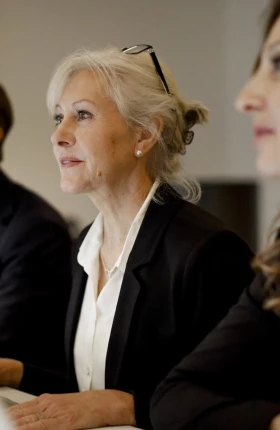We live in an age where technology underpins growth and competitiveness. Seven of the world’s ten most valuable companies rely primarily on digital platforms , and digital natives are disrupting a broad range of industries. Most nondigital incumbents recognize the need for digital transformation and have embarked upon major change efforts, especially after the fillip to digital business models delivered by COVID-19.
But adopting technology is a means, not an end in itself. What, then, should be the aim of digital transformation ? By being crystal clear about the goals and how to reach them, we can improve our odds of success.
Competitive Advantage
Until about the middle of the 1980s, business strategy was predicated on static advantage derived from superior scale and position; it was operationalized though annual planning cycles; and it was applied at the level of business units or companies, which competed within clearly defined industries. This was appropriate in the context of a relatively stable and predictable business environment.
But the rapid development of computing and communication technologies has altered the nature of competition in fundamental ways: sustainable competitive advantage has given way to serial temporary advantage, planning has given way to organizational learning, and individual corporations are increasingly embedded in collaborative ecosystems that often span across industries. Furthermore, the scale of economic activity is pushing up against planetary and social limits , and externalities such as global warming, biodiversity loss, and social inequality must now be considered integral aspects of strategy.
Effective strategy has thus become less mechanical (durable, engineered blueprints for stable, decomposable, and predictable systems) and more biological (adaptation in complex, dynamic, interconnected, and unpredictable systems). Transforming enterprises for the new environment must therefore embrace this more biological conception of strategy and organization.
Organizations as Machines
The company can be considered a machine—an apparatus comprising separate parts, designed by humans to perform a particular task. We typically think of machines as mechanical or electromechanical devices combining simple machines like gears, pulleys, levers, wheels, and axles with a power source to perform a repetitive task. In organizational terms, this concept historically meant combining labor, capital, and technology with processes that delivered a stable set of products most efficiently.
This stands in stark contrast with biological organisms, which are not deliberately arranged to perform a repetitive task. Instead, they self-organize, interact, change, learn, reproduce, and evolve under changing conditions. However, in principle there is no reason we cannot design organizational machines with the biological properties more appropriate to today’s environment.
Launching digital transformation programs aimed merely at applying technology for more efficient execution of today’s tasks within today’s organizational context is therefore of limited value. We should step back and ask ourselves, “What sort of machines do we need for our new aims and context?”
Perception, Action, and Sociality
To understand the implications of today’s interconnected, dynamic environments for organizational design, we must therefore take a detour into biology. Estonian biologist Jakob von Uexküll first framed the idea that an organism doesn’t perceive the environment as it is, but rather a skewed version of it constrained by the organism’s sense
At one level humans are no different: our worldview is limited by our five senses, by the things we can and can’t do, and by our capacity for communication with others. We don’t spend a lot of time thinking about navigating electrical gradients, flying, or reading the minds of animals, because we can’t do those things unaided. However, there are also some important differences. As humans, we can be aware that our worldview is not complete or objective; we can deliberately shape it by learning, moving, or refocusing our senses and thoughts; and we can extend it by using technology to enhance our senses and capabilities. Furthermore, we can act socially to understand and influence the worldview of others, either by directly communicating new ideas or by manipulating the shared context, thus shaping the stimuli that others receive.
Exercising these capabilities, we have the power to shape our individual and collective worldviews. But we don’t always use this power intentionally or skillfully. The value of doing so is increasing as business strategy becomes more biological.
Implications for Digital Transformation
By stepping back in this way, we can see the bigger picture of how technology can make companies fitter for the new business environment. Beyond merely executing today’s processes more efficiently, technology can also reshape how we sense and act on information. In particular, we can digitally transform our organization’s powers of perception and cognition, its ability to take collective action, and its ability to do so sustainably, in several ways:
- Extend the senses of the organization. Technology can not only process data more rapidly but also expand our reach beyond the traditional boundaries of the organization. For example, many leading tech companies have built massive digital ecosystems that give them access to data from a wide range of suppliers, customers, and other external sources. Sensors and Internet of Things technology can also increase sensing ability by capturing new sources of data.
- Create connected digital learning loops. Traditionally, organizational learning was gated by the rate at which human decision makers could learn from and act on information. But with the advancement of artificial intelligence, companies are now capable of learning and acting at algorithmic speed. To achieve this, data systems must be connected to AI algorithms, which in turn feed decision engines that can act without human intervention—and those actions create new data, forming an integrated learning loop. For example, Netflix’s recommendation platform captures granular consumer behavior, analyzes it at scale, and produces automated, personalized recommendations that evolve over time.
- Focus humans and algorithms on their respective areas of strength. Algorithms can identify patterns in data much more quickly and powerfully than humans can. By delegating more such tasks to machines, humans can
focus on leveraging their own unique cognitive abilities, such as imagining new possibilities that don’t yet exist. For example, Amazon has autonomized routine decisions such as inventory management and pricing under a philosophy known as “Hands Off the Wheel,” refocusing human talent on coming up with new ideas, such as the company’s Amazon Go stores. New human-algorithm interfaces will also be required to make these very different styles of cognition work together
synergistically.3 3 ”How Amazon Automated Work and Put Its People to Better Use,” Harvard Business Review, September 16, 2020. - Facilitate communication between brains. In order for new ideas to reach their potential, they must spread from one person to many, which allows them to be acted upon and to evolve. Technology can be used to help understand and accelerate the spread of ideas throughout an organization. For example, metadata on people’s interactions can be used to create a network map, with which you can identify “brokers” who bridge different functions or groups and who may therefore be effective transmitters of new ideas.
- Facilitate cooperation. Even if ideas are spread widely, that may not be enough to cause everyone to buy in and act on those ideas. Collective organizational action involves changing the beliefs of many individual actors. Technology is no panacea here, but when harnessed correctly, digital platforms help scale and accelerate collective action. For example, Wikipedia has enabled millions of users to contribute and organize their knowledge into a freely available, massively comprehensive digital encyclopedia.
- Diagnose system health and overcome planetary and social limits. Businesses do not operate in a vacuum; environmental and social challenges are increasingly relevant problems for businesses across sectors. Businesses should focus integrated learnings loops, human cognition, collective platforms, and other new technologies not only on solving their individual business problems but also on solving the largest global challenges facing us today.
There is one area, however, where technology will not help: setting the purpose of a business. Only we can decide the human ends to which technology and the corporation are applied. Each company must determine why it exists and how it creates the intersection of capabilities, aspirations, and social needs—and this must guide transformation efforts. Whether financial performance is an end in its own right is a question of social norms, and these are shifting rapidly away from the idea that a corporation’s only goal should be to maximize shareholder value.
The Power of Biological Organizations
The outlined technology agenda fits with a broader strategic agenda to embrace and thrive amid uncertainty and complexity, instead of trying to engineer them away. This approach may be uncomfortable to many leaders who have been trained to maximize short-run efficiency, not learning or social contribution. Leaders can reshape their digital transformational efforts to tap into a new biological paradigm by asking several pivotal questions:
- Do our efforts expand the perceptive power of the organization?
- Do our efforts enhance the learning capability of the organization?
- Do our efforts create autonomous digital learning systems?
- Are the roles of humans and algorithms segmented to best effect?
- Is human cognition focused on more unique capabilities like imagination and empathy?
- Do our efforts help tap into the power of external ecosystems?
- Do our efforts help capitalize on emergent opportunities, or are they mainly plan-based?
- Have we reconceived the organization as a dynamic hybrid of technology and people, as opposed to a static human reporting structure?
- Are we using technology to increase the sustainability of the systems our enterprise relies upon?
- Does our company serve a clearly articulated social purpose?
Companies that embrace this broader biological conception of technology, organization, and strategy will be more likely to survive and thrive in a turbulent future.
The authors thank Bob Goodson, president of NetBase Quid, for introducing the power of the concept of the umwelt to them as they discussed with him the role of imagination in business .









